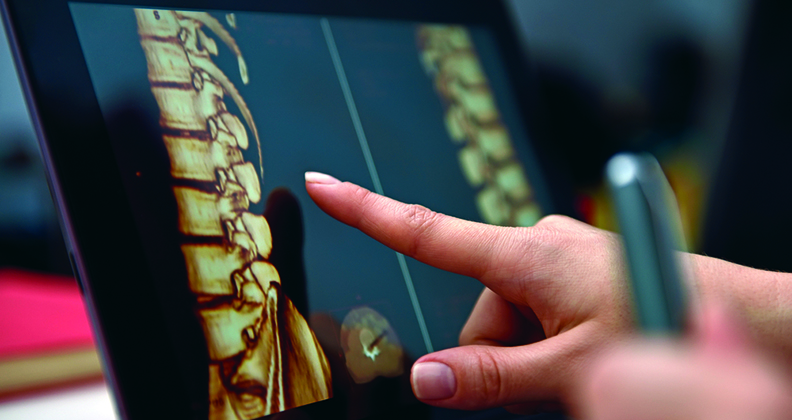
“A rollercoaster” is how spine surgeon Eeric Truumees, M.D., describes 2020.
Dr. Truumees is CEO of the Seton Brain and Spine Institute, a Professor of Orthopedic Surgery at the University of Texas, Dell Medical School and First Vice President of NASS’s Board of Directors. He is navigating today’s environment through the lens of an executive, clinician and industry leader. He believes that continued collaboration and conversation will allow people within the specialty to keep an eye on the big picture while experiencing the ups and downs brought on by COVID.
NASS’s Annual Meeting is a prime moment for that collaboration and conversation, he said. While the meeting is virtual this year, Dr. Truumees said the format will allow a broader group of people to discuss spine care today and in the future.
In preparation for surgeon and industry discussions at NASS, we asked Dr. Truumees four questions about the impacts he’s seen from COVID-19 in his practice, trends in spine and what he’s looking forward to at the Annual Meeting.
1. What has been your experience as a spine surgeon and hospital executive in the last six months?
Dr. Truumees: It’s been a rollercoaster. We’ve had temporary impacts on our elective surgeries for various reasons in the past, but nothing this broad or long-lasting.
There have been phases. Back in March, we didn’t know what was going to happen. Then, during April and May, everyone was sheltering at home; we were only doing urgent procedures, and even those were down because there was less driving and vehicular trauma.
At least here in Texas, it’s been a rollercoaster of decreasing cases and then returning to elective surgery and cases go back up, and back and forth. From a planning and budgetary standpoint, it’s been next to impossible, but things seem to be gradually getting better.
We were expecting a lot of catch-up surgery. There is some of that, but not as much as I expected. On the non-elective side, we’re seeing fewer patients but with more severe problems like tumors or spinal infections that didn’t get early management. They end up having higher surgery rates and bigger operations than they may have had otherwise due to lack of early management.
I tried to make predictions on the recovery to my colleagues a couple of months ago. Some things surprised me. We thought that we would begin elective surgeries with young patients with simple operations that don’t require ICU stays and extended hospitalizations, but a lot of those patients are concerned about job loss and insurance issues. They are only now starting to come back at previous rates of surgery, and there hasn’t been nearly as much catch-up with those patients. On the other hand, some of the older patients, retirees and the Medicare population, have been more than happy to get their procedures done because their other activities have all been postponed.
2. How do you think COVID-19 will impact the way that spine care may be delivered in the future?
Dr. Truumees: COVID-19 will affect us in a number of ways, but I think a lot of it is going to precipitate trends that were there already.
Telemedicine has gotten a huge boost, both due to the pandemic and the response from insurers and CMS in regard to how they cover and pay for it. The increased accessibility of distanced consultations may very well lead to more subspecialization. You may see more cervical spine specialists, lumbar spine specialists, apart from the normal areas that deal with deformity and tumors.
The pandemic will accelerate minimally invasive surgery and endoscopic approaches because patients want to stay out of hospitals. They want to have procedures done in an outpatient setting or ASC or specialty hospital. That’s going to drive a lot of advancement around enabling technologies like navigation and robotics. The more we can do these procedures through smaller incisions and keep people away from long inpatient stays, the better off they’re going to be.
However, moving toward outpatient and ambulatory surgery center centers does pose some challenges. It will be up to the owner of each center to invest in these new technologies, like robots and nav systems. The hold on elective surgeries and other financial hits may delay these investments. But, on the payment side, the Centers for Medicare & Medicaid Services has clearly signaled that they’re getting rid of the inpatient-only list. As that moves forward over the next few years, I think a lot of the financial challenges will continue to decline and it’ll get easier to offer a wider swath of patients that kind of care. It’s really going to come down to which patients are healthy enough for care in that setting versus in a hospital.
3. What are some of the important topics to be discussed at NASS 2020 in October?
Dr. Truumees: The annual meeting will discuss both evolving and revolutionary approaches in spine care, as well as the best ways to achieve good sagittal balance of the spine patient and what’s enough surgery versus what’s too much. Another big part of this, though, is how we learn and how we share information. The virtual meeting for me means that I can seek input from a much broader group of people, but in smaller doses and more frequently.
There will be a focus on the important clinical topics and then more touchpoints over the course of the year to back up our knowledge base and make it practical for people to implement these technologies in their own practices.
4. Do you have any last comments you would like to share on the surgeon/OEM relationship?
Dr. Truumees: One area in which the industry has been a good partner is data collection, which will continue to show the value of the procedures we’re doing and the implants we’re using. There are a number of registries, such as AAOS and NASS. Supporting those efforts will help all of us in the end as we work to show who will benefit the most from procedures, keep our eye to decrease risks and improve quality. Those are arguments we’re going to need to make to payors and the population at large. COVID-19 will only increase fear and, therefore, the need to demonstrate the worth of these procedures and why we should spend money on them.
CL
Carolyn LaWell is ORTHOWORLD's Chief Content Officer. She joined ORTHOWORLD in 2012 to oversee its editorial and industry education. She previously served in editor roles at B2B magazines and newspapers.




